Managing wine extraction, retention, clarity and stability for defined styles and efficient production
Project summary
The project will investigate:
- the role of macromolecules such as tannins, polysaccharides, proteins and their aggregate colloids, and their impact on stability, clarity, filtration and fouling;
- the impact of other wine matrix components on macromolecule extraction, retention and function;
- the source of these molecules or their precursors in grapes and yeast, and the impact of winemaking processes such as clarification, flotation, vinification and filtration on their retention and/or transformation;
- the impact of fouling of surfaces by macromolecules leading to production inefficiencies;
- alternative strategies for achieving protein stability and cold stability, for example, through use of novel additives and/or processing techniques;
- practical methods for wineries to determine likely extractability of macromolecules during winemaking and the factors that affect extraction and retention (e.g. enzymes, water additions and heat treatments).
Latest information
New insights on how composition affects cold instability differently for red and white wines
The management of potassium tartrate (KHT) instability in wine is critical, as the presence of KHT crystals in packaged wine can be perceived by consumers as a wine fault. Traditional cold stabilisation represents one of the most expensive aspects of the winemaking process, due to the energy use and time required for cooling, as well as the potential for wine volume loss. Besides developing alternative methods for cold stabilisation, it is also important to understand the compositional factors which lead to KHT instability. A comprehensive survey of red and white wine composition and cold instability was conducted over two seasons, in order to identify wine compositional factors which may contribute to cold instability. For unfined white wines, it was found that lower concentrations of wine tartaric acid and high potassium largely explained KHT crystal formation, and this was not clearly influenced by macromolecules such as polysaccharides, proteins and phenolics. A follow-up study used purified fractions of the principal macromolecules in white wine, combining them within the range of concentrations expected in wine. Protein and phenolics (flavonoids and hydroxycinnamic acids) were found to slightly reduce KHT crystal formation either independently or in combination (Figure 11A). White wine polysaccharides had no impact on KHT crystal formation, contrary to expectation (Figure 11B). The inhibition of KHT crystallisation by phenolics was removed when polysaccharide was present. However when protein was combined at higher concentrations with polysaccharide, a small drop in KHT crystal formation was found, but not to the extent found for protein alone. These results demonstrate why in white wine, which invariably has a substantial concentration of polysaccharides, the potentially protective influence of other macromolecules has little to no influence on KHT crystallisation.
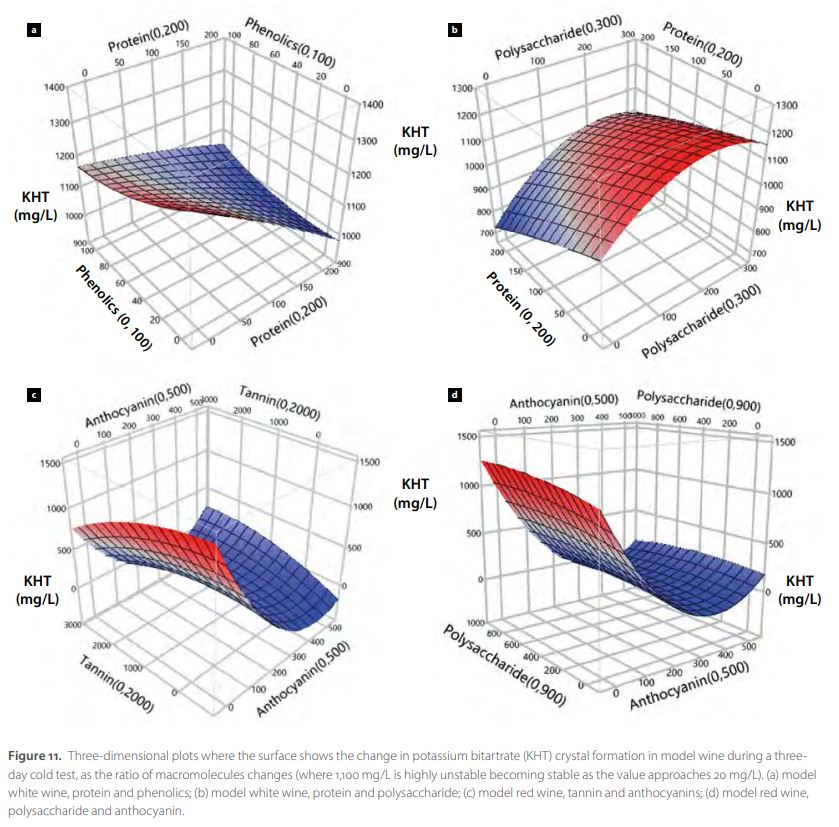
A corresponding experiment with unfined red wines over two seasons produced some interesting results. Higher tannin concentrations were invariably associated with increased cold instability, and the ratio of tartaric acid to potassium was not important. As for white wines, polysaccharides were found not to be an important inhibiting factor in KHT crystallisation in red wines, which was unexpected. Wine colour, total anthocyanin and polymeric pigments were significant in the models developed, but depending upon the season had a variable relationship with cold stability.
Further investigation was conducted of the key red wine macromolecule categories (tannin, anthocyanin and polysaccharide) and their interactions for the range of concentrations expected in red wine. Contrary to what was expected from the wine compositional survey, tannin was found to introduce some protection against KHT crystallisation when applied in the higher concentration range (Figure 11C). Red wine polysaccharides, which are present at higher concentrations in red wines than in white, also showed no protective effect against KHT crystallisation. Red wine polysaccharides also reduced the inhibiting effect of tannin on crystal formation when in combination. Surprisingly, anthocyanin was found to bring the model wine close to cold stability, at the lowest applied concentration, and this effect was exerted even when tannin or polysaccharide were present (Figure 11C and D). It was found that the addition of anthocyanin to a bentonite-fined white wine or model wine was able to cold stabilise the wine to the same extent as a commercial dose of potassium polyaspartate. Although the potential role of anthocyanin in limiting KHT instability has long been known, these results potentially explain why the compositional study revealed a positive association between wine tannin and KHT crystal formation. Wines with higher tannin concentration may more rapidly undergo polymerisation reactions with anthocyanin, losing the protective monomeric structural forms. This suggests that the measurement of anthocyanin, and its expected conversion (and hence loss) to other forms over time, may provide a useful prediction of the likelihood of cold instabilities developing during red wine maturation.
Rapid detection of haze-forming proteins in white wine by fluorescence sensing technology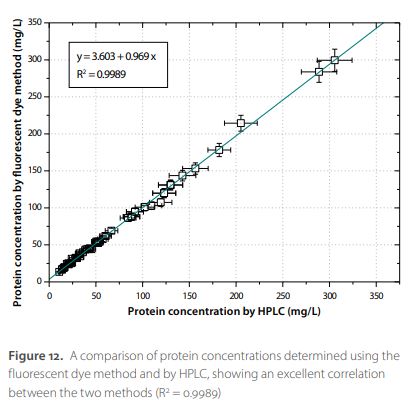
The heat test is the industry standard for measuring the propensity for haze proteins in wine to develop heat instability over time; however, it is time-consuming and often not sufficiently accurate. The lack of accuracy may lead to over-fining with bentonite, which might strip wine phenolics and aroma compounds, or under-fining, which increases the risk of protein instability. This problem was addressed by developing an efficient and selective fluorescence-based sensing technology to detect haze-forming proteins in white wine. The newly developed method is simple, provides rapid results, and is accurate, being selective for haze-forming proteins, providing a linear detection range and a low detection limit of 2 mg/L. The usefulness of the technology was validated using a wide range of white wines. To confirm the accuracy of the protein concentration determined with the fluorescent dye, the protein concentration in the wines was also measured by HPLC. A linear regression of results was prepared for all wines studied, with an excellent R2 value (Figure 12), indicating that the amount of total protein calculated using the dye closely approximated the amount measured by HPLC (which quantifies both thaumatin-like and chitinase proteins individually). In addition, using the fluorescent dye method, a baseline protein level below which haze in white wine did not occur was found to be 12 mg/L for this diverse sample set. Given that certain wines may be heat stable at substantially higher protein concentrations, the protein detection approach cannot immediately replace the heat test, as it presents a risk of over-fining if extremely low protein levels are targeted. Instead, it is suggested that rapid protein detection could be used as an initial screen to determine if the protein concentration is above the threshold for instability and, after that, the heat test could be used to predict protein stability only on those samples above the threshold.
Can accelerated maceration improve the extraction of phenolics in red winemaking?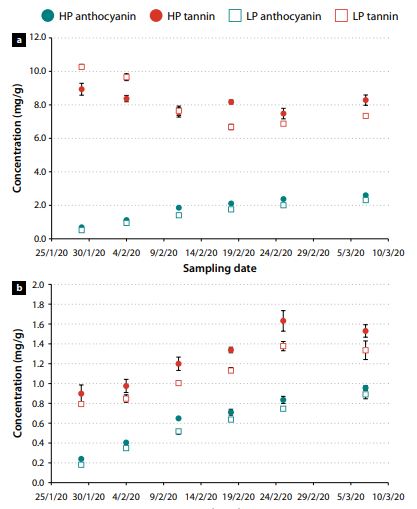
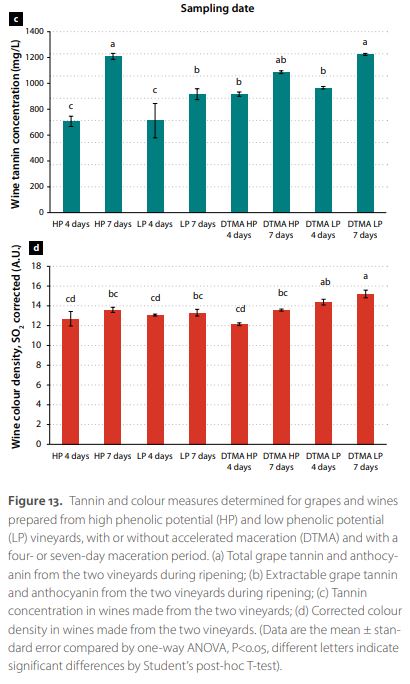
Coriole in McLaren Vale has recently implemented Della Toffola’s maceration accelerator (DTMA) as one of its winemaking tools. This maceration technique was developed for low-phenolic varieties such as Pinot Noir, and aims to gently cut the skins of the grape berry, facilitating the extraction of tannin and colour, without damaging the seeds. It has also been trialled on other grape varieties such as Shiraz, with some success (Kang et al. 2020). An AWRI collaboration with Coriole aimed to compare changes in ‘phenolic potential’ (an assessment of both total and extractable tannin, anthocyanin and phenolics) of its Shiraz vineyards during ripening. It was found that extractable tannin and colour increased during ripening for all vineyards, while total tannin decreased gradually, and then remained constant (Figure 13). From this assessment, two vineyards designated ‘high phenolic potential’ and ‘low phenolic potential’ were selected. The grapes from these two vineyards were harvested at commercial ripeness and underwent either standard crushing or DTMA. The maceration times were also varied, with either a short maceration (four days) or a standard maceration (seven days). For wines prepared from the low phenolic potential vineyard, DTMA maceration was very effective at increasing phenolic extraction. This was evident for both tannin and colour (Figure 13), even after four days of maceration. For the high phenolic potential vineyard, however, DTMA did not affect phenolic extraction and the DTMA-treated low phenolic potential wines had an equivalent tannin concentration to the high phenolic potential wines, and a higher colour after seven days of maceration. For both vineyards, DTMA did not change the composition or size of the tannin, confirming previous reports that tannin is not selectively extracted from damaged seeds. It was interesting to find that for the low phenolic potential vineyard, DTMA increased the extraction of grape pectins into the wine (result not shown), but these were unaffected for the high phenolic vineyard. This may indicate that grapes with high phenolic potential could also have relatively degraded and porous skins which facilitate the extraction of both tannin and pectins. For the low phenolic potential vineyard, the use of DTMA may have increased skin breakage, facilitating the release of otherwise non-extractable tannin and polysaccharide from the grapes during maceration. The work has shown that DTMA is a relatively gentle maceration technique, which winemakers could use to improve phenolic extraction from low-phenolic fruit.
Digging deeper into how aeration during red winemaking affects phenolics
Oxygen plays an important role in wine quality, and is known to improve red fruit attributes, decrease astringency and decrease reductive odours (Day et al. 2021). It is thought that oxygen can accelerate the transformation of the wine phenolic matrix, effectively ageing the wine more rapidly. Indeed, aeration during red wine fermentation has been found to affect both the structure of wine tannin and its reactivity with salivary proteins, potentially affecting wine astringency or bitterness. To further the AWRI’s work on oxygen and phenolics, a new study was initiated with two main aims. Firstly, a fractionation protocol was adapted to isolate discrete classes of phenolics in red wine (Figure 14), in order to identify impacts of oxygen on phenolic composition using mass spectrometry. This was applied to Shiraz wines which had undergone different levels of aeration during fermentation, from reductive (control) through to high oxygen (HiOx). The second objective was to characterise the potential interaction of the different phenolic fractions with proteins in saliva, using polyproline as a model salivary protein. A binding affinity study was performed using isothermal titration calorimetry (ITC). The result for the fraction containing polymeric material including tannins and pigmented polymers (Fraction 5) is included in Figure 14. Comparing the ITC results for the control and HiOx treatments, a very different binding pattern with polyproline was found. Contrary to what was expected, Fraction 5 from the control wine did not bind to polyproline (data not shown). However, ITC of the same fraction prepared from the HiOx treatment indicated binding events had occurred. The binding was found to be a low entropy binding with a secondary weak association. Hydrophobic linkages were also detected between Fraction 5 and polyproline. Work is continuing to understand the response of each of the fractions using ITC, and to further characterise their composition with mass spectrometry. Generally, the results suggest that oxygen can bring about structural changes to phenolic polymers that directly affect tannin-protein interactions, potentially influencing both their stability (solubility) in wine and perceptions of wine texture (e.g. astringency or bitterness).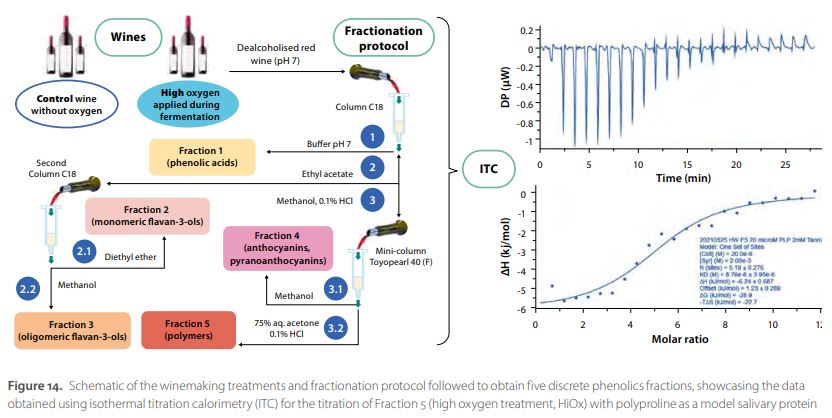
Harnessing ultrafiltration technology to manage wine phenolics
Ultrafiltration is one of a number of membrane filtration techniques available to the wine industry. It differs from the more widely used cross-flow microfiltration in that the semi-permeable membranes used have a far lower pore size (5-20 nm). The power of this technique is that it is able to remove or concentrate macromolecules of interest in the permeate or retentate respectively, including proteins, polysaccharides and phenolics. Ultrafiltration has recently been applied with some success to improve the heat stability of white wine by removing haze-forming proteins (Sui et al. 2021) and in the process was shown to also remove phenolics. To follow on from this work, a new project was initiated by the University of Adelaide, applying ultrafiltration towards the recovery of valuable phenolic end-products from red wines, or to ameliorate phenolic faults in heavy-pressed or laccase-affected white wines. In a preliminary benchtop trial on a commercial red wine, spiral ultrafiltration membranes of nominal molecular weight cut-offs 10 kDa, 20 kDa and 75 kDa were used, aiming to achieve a permeation degree between 50 and 95%. While ultrafiltration had a negligible effect on wine alcohol and pH, all tannin and polysaccharide were sequestered in the retentate, irrespective of the pore size of the membrane or the permeation degree. Anthocyanin was also strongly retained by the ultrafiltration process, in particular for the 10 kDa membrane, producing a concentrated retentate with an intense colour. Since phenolics such as tannin and anthocyanin are in fact far smaller than the nominal molecular weight cut-off of the membranes, this points to interactions (including fouling) at the membrane surface preventing permeation. Future work will continue to investigate the fouling phenomenon as well as the potential application of ultrafiltration to modulate phenolics in commercial winemaking, with a stronger focus on white wine production.
References
Day, M.P., Espinase Nandorfy, D., Bekker, M.Z., Bindon, K.A., Solomon, M., Smith, P.A., Schmidt, S.A. 2021. Aeration of Vitis vinifera Shiraz fermentation and its effect on wine chemical composition and sensory attributes. Aust. J. Grape Wine Res. 27(3): 360-377.
Kang, W., Bindon, K.A., Wang, X., Muhlack, R.A., Smith, P.A., Niimi, J., Bastian, S.E. 2020. Chemical and sensory impacts of accentuated cut edges (ACE) grape must polyphenol extraction technique on Shiraz wines. Foods. 9(8): 1027.
Sui, Y., McRae, J.M., Wollan, D., Muhlack, R.A., Godden, P., Wilkinson, K.L. 2021. Use of ultrafiltration and proteolytic enzymes as alternative approaches for protein stabilisation of white wine. Aust. J. Grape Wine Res. 27(2): 234-245.
Project Contact
Keren Bindon

